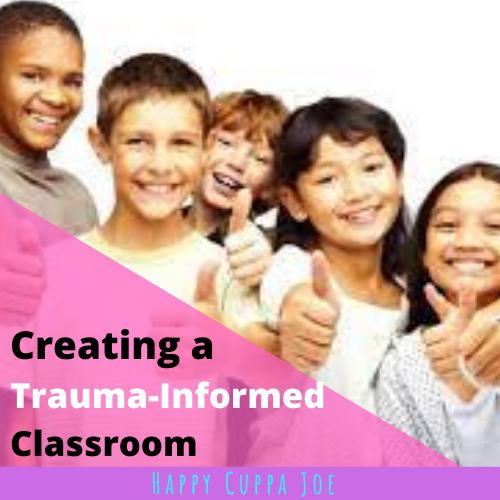We know that trauma effects many of the students coming into our classrooms, especially when we consider our EAL population and the number of students that will end up negatively affected by the Covid-19 Pandemic. We also know that childhood trauma has long-term health effects and can impair many of our students’ social-emotional and academic skills.
So how can we help support our students by creating a trauma-informed classroom?
We can begin by creating a safe learning environment for our students that fosters connections, mutual respect, and empowering our students. Making sure that our students feel safe in a predictable environment is an essential step towards helping them grow as learners. We should also ensure adequate training for ourselves and for all staff so we’re able to properly implement Tier 1 Intervention strategies.
For more info on multi-tiered interventions, be sure to check out this article on the Multi‑tiered Approaches to Trauma‑Informed Care in Schools.
These strategies include teaching our students social as well as emotional regulation skills. And as always, don’t forget to consider Self-Care Strategies and make sure that you’re taking care of yourself, our jobs can be tough!
Safe Learning Environments
In order to create an inclusive classroom that fosters a sense of belonging for each of our students, we need to emphasize connections, relationships, and mutual respect in our classrooms. We should also include students in this process by teaching the importance of the collective classroom. This will help them to feel a sense of control and can decrease the chances of them engaging in disruptive behaviors or other survival tactics that they have come to depend on. Make sure that your students feel secure and comfortable in your classroom by building and maintaining strong relationships, which will in turn allow them to learn and grow.
Remind yourself to consider what has happened to a student, rather than what’s wrong with a student. When we do this, we come from a place of empathy rather than frustration. It’s also extremely important and beneficial to make connections with your students to help build positive relationships. Just as Lisa Godwin points out in this Ted Talk on How Teachers Can Help Students Navigate Trauma, you may just be the one person that reaches a student in need!
Daily Routines and procedures that students can come to expect are also an important part of a trauma-informed classroom. Structures such as these that your students can expect provide consistency and predictability which are both very important to children who have experienced trauma. As a part of your regular day, you might also want to include things like yoga, meditations, and mindful moments. Teaching students to slow down and take in these moments can help teach them to more easily manage their distress, regulate their emotions and lessen their impulsive urges. Teaching mindfulness has also been shown to increase resilience, improve self-awareness, and help to develop a positive mindset.
Tier-1 Interventions and Programs
There are many things that we can keep in mind as we try to create inclusive classrooms, but we can’t be expected to know it all. That’s why it’s important to lean on solid programs that are backed by research to help teach our students social and emotional regulation skills. Here are a few that I have come across that I have thoroughly enjoyed teaching!
Each of these programs comes with easy to follow guides and requires little to no prep work on the teacher’s part.
For more information on these programs, check out my blog post on Resources for the Trauma-Informed Classroom!
While researching for this blog, I also came across Psycho-Educational Therapy– a combination of expressive arts with trauma-informed therapy. Creative arts is known to access the same non-verbal part of the brain that holds traumatic memories, which means that it can also be an outlet for students to understand and process their traumas.
To find out more about how creative arts can help your students express themselves and work through traumatic experiences, check out this article from the University of Regina called Empowering Students in the Trauma-Informed Classroom Through Expressive Arts Therapy.
The ARC Framework is another useful guide to teaching students with a history of childhood trauma. It stands for attachment, regulation, and competency. This is another guide that I look forward to trying in my next classroom. The basic premise for this framework is:
- Attachment
- If we can remember that much of their childhood has been filled with chaos and unpredictable days, then we can start to consider how to counter the effects and consequences of severed attachment in our classroom. We can do this by helping our students feel safe and secure by providing structure in the form of predictable routines and procedures. Examples of this can be as simple as ten minutes of quiet reading in the morning or after each recess, or maintaining control during transition times by teaching quick and quiet lining up procedures.
- Regulation
- Children who have grown up in war-torn countries will often deal with the trauma by disassociating themselves from their feelings. What this can mean in our classroom is that they are coming to school without the capacity to handle normal everyday stressors such as disagreements with a peer. We can help our students learn important self-regulation strategies and manage these experiences with explicit instruction on identifying and regulating these emotions as they arise in the classroom.
- Competency
- We also need to understand that with the interference that trauma can have on a child’s development comes a delay to typical competencies associated with their age group. Teaching students goal setting, planning strategies, and that our actions have consequences is one way to help repair these delays.
For more information about the ARC Framework, or about how to support our EAL learners in our classrooms, make sure to check out this article from the BC Teal- Trauma-informed Teaching Practice and Refugee Children: A Hopeful Reflection on Welcoming Our New Neighbours to Canadian Schools
Self-Care Strategies
Working with students that have been negatively affected by trauma can have a negative effect on teachers as well. This is known as secondary trauma, and it’s definitely something you want to be mindful of. This makes it extremely important for us to be self-aware of our own feelings and put the time and efforts into taking care of ourselves.
Some of the ways that we can be proactive in this regard are:
- Leaning on co-workers with positive attitudes
- Putting healthy lifestyles high up on our list of priorities, including a balanced diet and daily exercise
- Yoga, Meditations, journaling, or other quiet and calming activities
For more great self-care practices and ideas for reflection, check out these awesome resources!
These resources were provided in a Current Issues in Counselling class that I took with Dr. Blythe Shepard, and I found them to be very informative. Working my way through these reflections reminded me to get back to the basics as far as self-care strategies go and make sure I take care of myself first.
Remember, the better you can care for yourself, the better you will be able to care for your students!
Micki Banks
Latest posts by Micki Banks (see all)
- Masters Portfolio - October 15, 2024
- Graduate Summative - October 15, 2024
- Expressive Therapies - October 15, 2024


